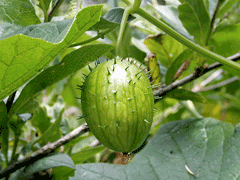 |
|
http://flickr.com/photos/cpurrin1/ |
 |
|
Translate this page:
Summary
Physical Characteristics

 Echinocystis lobata is a ANNUAL growing to 8 m (26ft 3in) at a fast rate.
Echinocystis lobata is a ANNUAL growing to 8 m (26ft 3in) at a fast rate.
It is frost tender. It is in leaf from May to October, in flower from July to September. The species is monoecious (individual flowers are either male or female, but both sexes can be found on the same plant) and is pollinated by Insects. The plant is self-fertile.
Suitable for: light (sandy), medium (loamy) and heavy (clay) soils and prefers well-drained soil. Suitable pH: mildly acid, neutral and basic (mildly alkaline) soils. It cannot grow in the shade. It prefers moist soil.
UK Hardiness Map
US Hardiness Map
Synonyms
Sicyos lobata.
Plant Habitats
Cultivated Beds;
Edible Uses
References More on Edible Uses
Medicinal Uses
Plants For A Future can not take any responsibility for any adverse effects from the use of plants. Always seek advice from a professional before using a plant medicinally.
Analgesic Aphrodisiac Poultice Tonic
The pulverized root is used as a poultice for headaches[61, 222]. A very bitter tea brewed from the roots is analgesic and is also used as a love potion[61, 207, 222]. It is used as a bitter tonic for alleviating stomach troubles, kidney ailments, rheumatism, chills, fevers etc[61, 222, 257].
References More on Medicinal Uses
The Bookshop: Edible Plant Books
Our Latest books on Perennial Plants For Food Forests and Permaculture Gardens in paperback or digital formats.

Edible Tropical Plants
Food Forest Plants for Hotter Conditions: 250+ Plants For Tropical Food Forests & Permaculture Gardens.
More

Edible Temperate Plants
Plants for Your Food Forest: 500 Plants for Temperate Food Forests & Permaculture Gardens.
More

More Books
PFAF have eight books available in paperback and digital formats. Browse the shop for more information.
Shop Now
Other Uses
Beads
The seeds have been used as beads[257].
Special Uses
References More on Other Uses
Cultivation details
Prefers a sunny position in a well-drained rich soil with abundant moisture[1, 175]. Succeeds in ordinary garden soil[175]. A climbing plant, supporting itself by means of tendrils[219].
References Carbon Farming Information and Carbon Sequestration Information
Temperature Converter
Type a value in the Celsius field to convert the value to Fahrenheit:
Fahrenheit:
The PFAF Bookshop
Plants For A Future have a number of books available in paperback and digital form. Book titles include Edible Plants, Edible Perennials, Edible Trees,Edible Shrubs, Woodland Gardening, and Temperate Food Forest Plants. Our new book is Food Forest Plants For Hotter Conditions (Tropical and Sub-Tropical).
Shop Now
Plant Propagation
Seed - sow early spring in a rich compost in a greenhouse, placing 2 - 3 seeds in each pot. The seed usually germinates within 1 - 2 weeks at 20°c. Thin the seedlings to the best plant in each pot, grow them on fast and plant them out after the last expected frosts[175]. Give the plants some protection, such as a cloche, until they are growing away well.
Other Names
If available other names are mentioned here
Native Range
NORTHERN AMERICA: Canada (Québec, Nova Scotia, Ontario, Prince Edward Island, New Brunswick, Saskatchewan, Manitoba), United States (Connecticut, Indiana, Maine, Massachusetts, Michigan, New Hampshire, New Jersey, New York, Ohio, Pennsylvania, Rhode Island, Vermont, West Virginia, Iowa, Kansas, Minnesota, Missouri, Nebraska, North Dakota, South Dakota, Illinois, Oklahoma, Wisconsin, Colorado, Idaho, Montana, Wyoming, Delaware, Kentucky (north), Maryland, North Carolina (northwest), New Mexico (north), Texas, Arizona, Utah (north))
Weed Potential
Right plant wrong place. We are currently updating this section.
Please note that a plant may be invasive in one area but may not in your area so it's worth checking.
Conservation Status
IUCN Red List of Threatened Plants Status :

Growth: S = slow M = medium F = fast. Soil: L = light (sandy) M = medium H = heavy (clay). pH: A = acid N = neutral B = basic (alkaline). Shade: F = full shade S = semi-shade N = no shade. Moisture: D = dry M = Moist We = wet Wa = water.
Now available:
Food Forest Plants for Mediterranean Conditions
350+ Perennial Plants For Mediterranean and Drier Food Forests and Permaculture Gardens.
[Paperback and eBook]
This is the third in Plants For A Future's series of plant guides for food forests tailored to
specific climate zones. Following volumes on temperate and tropical ecosystems, this book focuses
on species suited to Mediterranean conditions—regions with hot, dry summers and cool, wet winters,
often facing the added challenge of climate change.
Read More
Expert comment
Author
(Michx.)Torr.&A.Gray.
Botanical References
43235
Links / References
For a list of references used on this page please go here
Readers comment